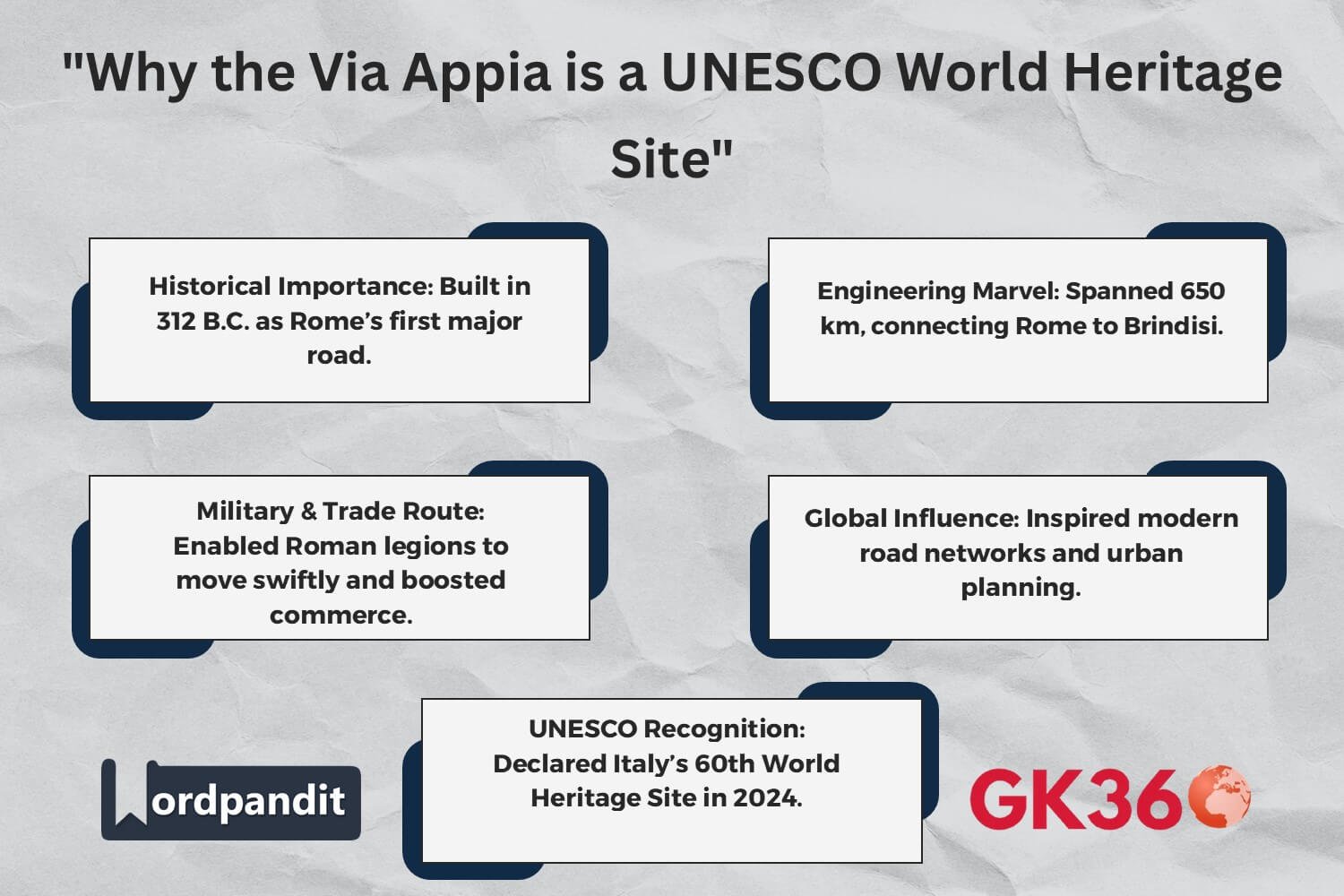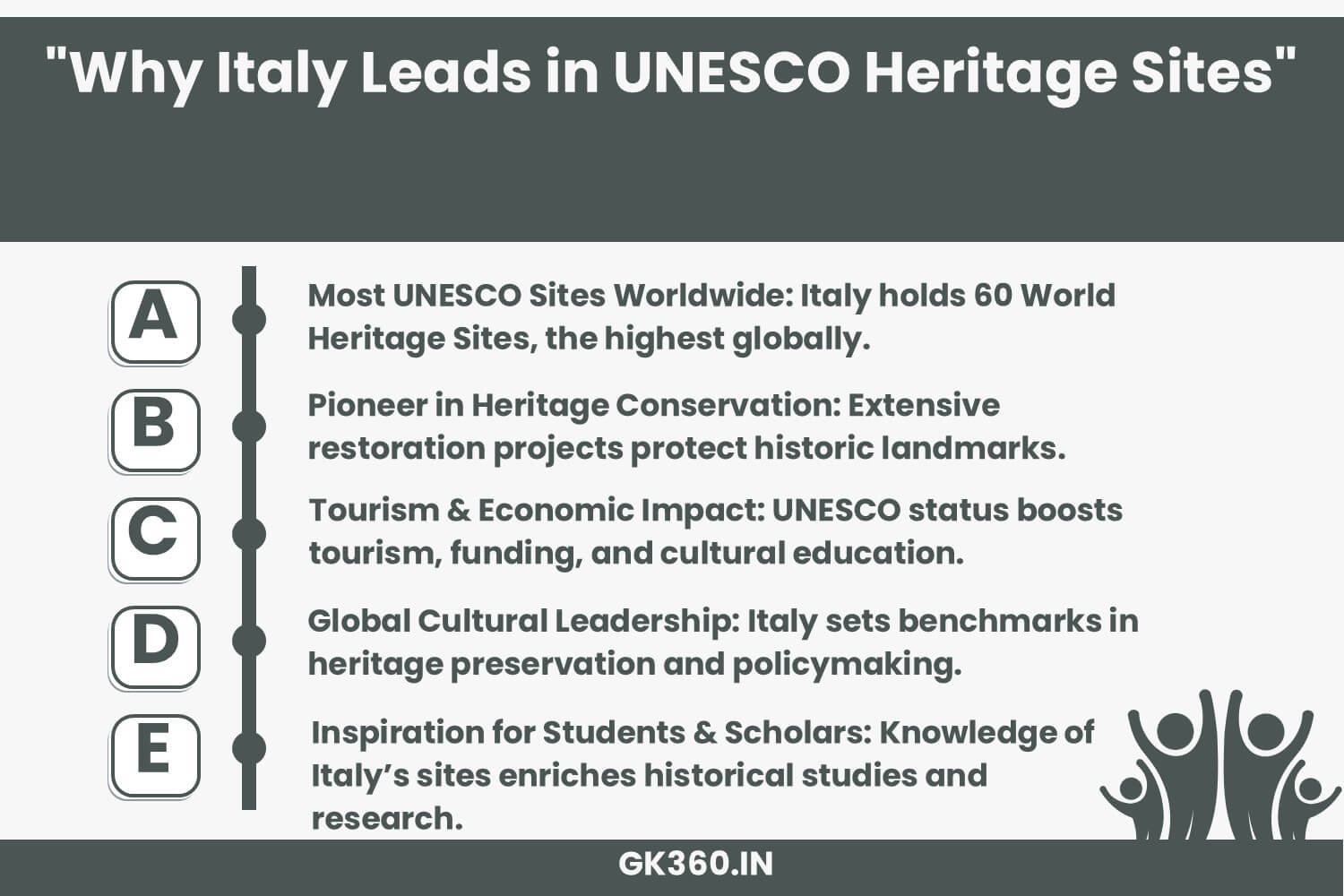Italy’s Via Appia: The 60th UNESCO World Heritage Site and Its Global Significance
Introduction
Italy, renowned for its rich cultural, artistic, and historical heritage, has further cemented its global legacy with the recent addition of the Via Appia Regina Viarum to the UNESCO World Heritage list. Announced during the 46th session of the World Heritage Committee in New Delhi, this recognition brings Italy’s total UNESCO-listed sites to 60, reinforcing its status as the country with the most UNESCO World Heritage Sites worldwide.
This article explores the significance of this latest inclusion, the historical importance of the Via Appia, and why Italy remains a global leader in heritage preservation.

Table of Contents
- Understanding the UNESCO World Heritage List
- Italy’s 60th UNESCO Heritage Site: Via Appia Regina Viarum
- Italy’s Leadership in Heritage Preservation
- Importance for Students and Competitive Exam Aspirants
- FAQs
- Conclusion & Call to Action
Understanding the UNESCO World Heritage List
- The UNESCO World Heritage List recognizes sites of outstanding universal value to humanity.
- Being listed ensures global protection and recognition for a site’s cultural, historical, or natural significance.
- Countries strive to have their most treasured locations added to the list to boost tourism, cultural awareness, and conservation efforts.
Italy’s 60th UNESCO Heritage Site: Via Appia Regina Viarum
Historical Significance
- The Via Appia was the first grand road of Rome, constructed using revolutionary engineering techniques.
- It was inaugurated in 312 B.C. by Appius Claudius Caecus to connect Rome to Capua and was later extended to Benevento, Venosa, Taranto, and Brindisi.
Construction and Use
- Originally built for military purposes, enabling the swift movement of Roman legions.
- Eventually became a major commercial and trade route, fostering economic and cultural exchanges across Italy.
- Set a precedent for Roman road-building techniques, influencing infrastructure development for centuries.
Cultural Impact
- The Via Appia’s durability and strategic importance helped shape the growth of the Roman Empire.
- Its legacy influenced future civilizations, inspiring modern road networks and urban planning.
- The road remains an architectural and historical marvel, attracting scholars and tourists alike.
Italy’s Leadership in Heritage Preservation
- Italy holds the highest number of UNESCO World Heritage Sites in the world.
- Its dedication to historical preservation, restoration, and cultural education has set global benchmarks.
- The government and cultural organizations work extensively to maintain and protect heritage sites, ensuring their survival for future generations.
Importance for Students and Competitive Exam Aspirants
- Understanding global heritage sites like the Via Appia is invaluable for students, especially those preparing for competitive exams in history, culture, and general studies.
- In History and General Studies Exams:
- Provides deep insights into Roman engineering, global trade routes, and historical influence.
- Enhances answer quality for questions on ancient civilizations and cultural heritage.
- In Essay Writing:
- Adds substantial examples to essays on cultural preservation, tourism, and globalization.
- In Interviews:
- Demonstrates awareness of global cultural heritage.
- Reflects strong analytical and critical thinking skills.

FAQs
- Why is the Via Appia significant? The Via Appia was Rome’s first major road, enabling military, trade, and cultural exchanges that shaped the Roman Empire.
- How does UNESCO select World Heritage Sites? UNESCO evaluates sites based on their historical, cultural, and natural importance, ensuring they possess outstanding universal value.
- How does Italy maintain its heritage sites? Italy invests in restoration, conservation, and legal protections, ensuring long-term preservation and global accessibility.
- What is the impact of a UNESCO listing? Recognition leads to greater funding, international protection, and increased tourism, contributing to local economies and cultural appreciation.
- How can students benefit from learning about heritage sites? Understanding historical landmarks enhances academic performance, critical thinking, and general awareness in exams and interviews.
Conclusion & Call to Action
The inclusion of the Via Appia in the UNESCO World Heritage list is a monumental achievement for Italy, reinforcing its status as a guardian of world heritage.
For students and competitive exam aspirants, exploring heritage sites like the Via Appia enriches their historical knowledge and strengthens their academic and professional pursuits.
📌 Take Action:
- Deepen your understanding of world heritage.
- Incorporate cultural insights into your studies and discussions.
- Stay updated with global cultural developments at gk360.in. 🌍
Key Takeaways Table
| Aspect | Details |
|---|---|
| UNESCO Recognition Date | 2024 (46th UNESCO Session in New Delhi). |
| Via Appia’s Length | 650 km, connecting Rome to Brindisi. |
| Historical Importance | First Roman road (built in 312 B.C.), vital for military & trade. |
| Engineering Significance | Revolutionary road-building techniques still influencing modern roads. |
| Cultural Impact | Inspired urban planning & infrastructure worldwide. |
| Italy’s UNESCO Ranking | No.1 globally with 60 World Heritage Sites. |
| Tourism & Preservation | Boosts cultural tourism, funding, and academic interest. |
SEO-Driven Tags
- Via Appia UNESCO Heritage Site 2024
- Italy’s 60th UNESCO World Heritage Site
- Roman Roads and Their Legacy
- UNESCO World Heritage Sites in Italy
- Ancient Rome Infrastructure
- Importance of Via Appia in History
- Cultural Heritage Preservation in Italy
- Italy’s UNESCO Ranking 2024
- Tourist Attractions in Italy 2024
- Impact of UNESCO Heritage Listings





